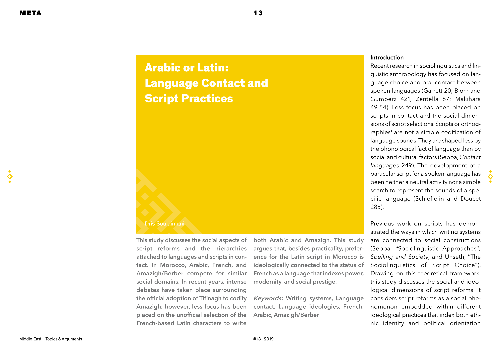Arabic or Latin: Language Contact and Script Practices
This study discusses the social aspects of script reforms and the hierarchies attached to languages and scripts in contact. In Morocco, Arabic, French, and Berber/Amazigh compete for similar social domains. In recent years, intense debates took place surrounding the official adoption of Tifinagh to...
I tiakina i:
| I whakaputaina i: | Middle East - Topics & Arguments |
|---|---|
| Kaituhi matua: | |
| Hōputu: | Artikel (Zeitschrift) |
| Reo: | Ingarihi |
| I whakaputaina: |
Philipps-Universität Marburg
2019
|
| Ngā marau: | |
| Urunga tuihono: | Urunga tuihono |
| Ngā Tūtohu: |
Kāore He Tūtohu, Me noho koe te mea tuatahi ki te tūtohu i tēnei pūkete!
|
| Whakarāpopototanga: | This study discusses the social aspects of script reforms and the hierarchies attached to languages and scripts in contact. In Morocco, Arabic, French, and Berber/Amazigh compete for similar social domains. In recent years, intense debates took place surrounding the official adoption of Tifinagh to codify Amazigh; however less focus has been placed on the unofficial selection of the French-based Latin characters to write both Arabic and Amazigh. This study argues that, besides practicality, preference of the Latin script in Morocco is ideologically connected to the status of French as a language that indexes power, modernity and social prestige. |
|---|---|
| DOI: | 10.17192/meta.2019.13.8080 |
